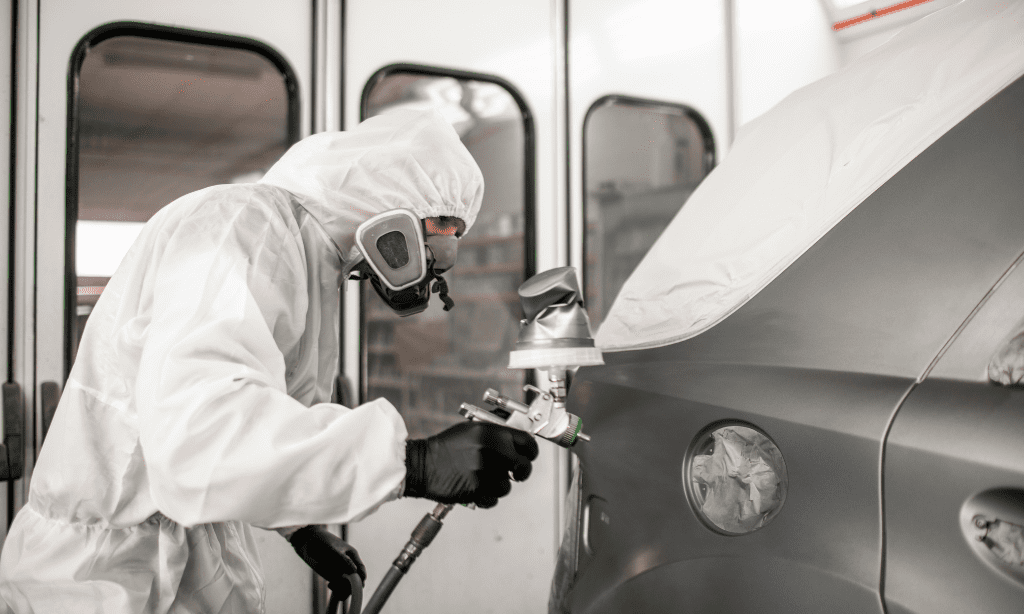Revolutionize Your Car Paint Job (Detailed Guide 2024)
It usually takes around 6 to 8 spray cans to paint a car completely. Painting a car requires careful consideration and planning to ensure a flawless and professional finish.
One important aspect is determining the number of spray cans needed to cover the entire vehicle. Generally, it takes approximately 6 to 8 spray cans to cover a car adequately. This estimate can vary depending on factors such as the car’s size, the color intensity desired, and the type of paint being used.
It is crucial to purchase enough cans to avoid running out in the middle of the project, ensuring consistent coverage and color throughout. By estimating the right quantity of spray cans, you can approach your car painting project with confidence and achieve impressive results.
Color Options To Consider
Are you considering giving your car a fresh new look? Choosing the right paint color is an exciting part of the process. The color you choose can transform your car’s appearance and reflect your personal style. From classic neutrals to bold metallic hues, there are endless color options available.
In this section, we will explore the factors to consider when selecting a paint color and provide some popular car paint colors to inspire you.
Choosing The Right Paint Color
When choosing a paint color for your car, it’s essential to consider the following factors:
- Personal preference: Take into account your personal taste and the image you want your vehicle to portray. Do you prefer a sleek and elegant look or a vibrant and eye-catching color?
- Vehicle type: Certain colors may complement specific car models or body styles better than others. Consider the shape and design of your vehicle when selecting a color.
- Practicality: Consider the practicality and durability of the paint color. Lighter colors tend to show dirt and scratches more easily, while darker colors may retain heat more.
Factors To Consider For Color Selection
Here are a few key points to keep in mind when selecting a paint color for your car:
- Climate: If you live in an area with intense heat or frequent exposure to sunlight, lighter colors can help reflect the heat and keep your car’s interior cooler.
- Resale value: If you plan to sell your car in the future, popular and timeless colors like white, black, or silver are often more appealing to potential buyers.
- Maintenance: Some colors may require more frequent washing and maintenance to keep them looking their best. Consider the level of effort you are willing to put into maintaining the color’s appearance.
Popular Car Paint Colors
To give you some inspiration, here are a few popular car paint colors that have stood the test of time:
- Classic white: A timeless choice that exudes elegance and sophistication. White cars are known for their clean and fresh appearance.
- Bold red: Red is a bold and attention-grabbing color that exudes confidence. It is often associated with speed and luxury.
- Sleek black: Black is synonymous with luxury and power. It offers a sleek and sophisticated look that never goes out of style.
- Metallic silver: Silver is a versatile color that complements a wide range of car models. It provides a modern and futuristic vibe.
- Cool blue: Blue hues are popular for their calming effect and association with reliability. From light baby blue to deep navy, there are various shades to choose from.
Remember, the color you choose is a personal decision that reflects your unique style. Consider these factors and explore different color options to find the perfect shade that will make your car stand out on the road. Happy painting!
Estimating Spray Can Quantity
Painting a car can be a daunting task, especially if you’re considering using spray cans instead of a professional paint job. But how many spray cans do you actually need to get the job done? Let’s break it down and explore some key points to help you estimate the quantity of spray cans required for your car painting project.
Understanding Paint Coverage
Before diving into how many spray cans you’ll need, it’s important to understand the concept of paint coverage. Paint coverage refers to the amount of surface area that can be covered by a certain quantity of paint. Different paints have varying levels of coverage, so it’s crucial to check the product label for this information.
Calculating Spray Can Coverage
To estimate the quantity of spray cans needed, you’ll need to calculate the coverage of each can. Here’s a step-by-step guide to help you out:
- Determine the size of your car: Measure the length, width, and height of your car. Multiply these measurements to find the total surface area.
- Determine the coverage per can: Check the can label for the coverage information. It is usually mentioned in square feet or square meters.
- Calculate the number of cans needed: Divide the total surface area of your car by the coverage per can. This will give you an estimate of the number of cans required to cover the entire car.
- Account for multiple coats: If you plan on applying multiple coats for a better finish, make sure to multiply the number of cans by the number of coats desired.
Factors Affecting Spray Can Quantity
While the calculation above will give you a rough estimate, it’s important to consider a few factors that can affect the quantity of spray cans needed:
- Surface condition: The condition of your car’s surface will determine whether it requires more or fewer coats of paint. Rough or damaged surfaces may require additional cans to achieve a smooth and even finish.
- Color selection: Darker colors often require more coats to achieve full coverage compared to lighter ones. This may result in a higher quantity of spray cans needed.
- Overspray: Spraying with cans can result in some amount of overspray, which may reduce the coverage per can. Take this into account when calculating the quantity of cans required.
- Skill level: If you’re new to painting with spray cans, you might need more cans to compensate for any mistakes or uneven spraying.
Remember, these factors can vary from person to person and car to car. It’s always better to purchase a few extra cans in case you run out during the painting process.
In Conclusion
Estimating the number of spray cans needed to paint a car requires some careful calculations and consideration of various factors. By understanding paint coverage, calculating spray can coverage, and factoring in other variables, you can make an informed estimate to ensure you have enough cans to complete your car painting project.
Happy painting!
Tips For A Successful Car Paint Job
Are you a car enthusiast looking to paint your own vehicle? If so, you might be wondering how many spray cans you will need to achieve a professional-looking finish. While the exact number can vary depending on the size of your car and the specific product you are using, there are some general tips and guidelines that can help you plan for a successful car paint job.
Prepping The Surface
Before you even think about applying any paint, it is crucial to properly prepare the surface of your car. Here are some key points to keep in mind:
- Start by thoroughly washing and drying the car to remove any dirt, grime, or debris.
- Next, sand down any rough spots or imperfections to create a smooth surface for painting.
- Use masking tape and plastic sheeting to protect any areas that you do not want to paint, such as windows, trim, and lights.
- Fill in any dents or scratches with a suitable auto body filler and sand again to ensure a seamless finish.
Applying Primer
Priming the car is an essential step that helps the paint adhere properly and provides a smooth base for the color coat. Consider these tips when applying primer:
- Choose a high-quality automotive primer that is specifically designed for use on cars.
- Apply the primer in thin, even coats, allowing each coat to dry completely before adding another.
- Use a sanding block to lightly sand the primed surface before moving on to the base coat.
Applying Base Coat
The base coat is where you get to add color and personality to your car. Here’s what you need to know about applying the base coat:
- Shake the spray can thoroughly to ensure the pigment is well mixed.
- Apply the base coat in smooth, even strokes, holding the can about 6-10 inches away from the surface.
- Aim for full coverage without thick layers. It is better to apply multiple thin coats than one heavy coat.
- Allow each coat to dry completely before adding another layer or moving on to the clear coat.
Applying Clear Coat
The clear coat adds a protective layer to your car’s paint job, enhancing its durability and shine. Keep these tips in mind when applying clear coat:
- Just like with the base coat, shake the can thoroughly before spraying.
- Apply thin, even coats of clear coat, ensuring that you cover the entire surface of the car.
- Allow the clear coat to dry completely between coats to prevent any streaks or drips.
- Once all coats are applied, let the clear coat cure for the recommended time before handling or waxing the car.
Proper Techniques For Even Coverage
Achieving an even coverage is essential for a professional-looking paint job. Consider these techniques for achieving the best results:
- Keep the can moving in a back-and-forth motion rather than focusing on one spot.
- Overlapping each stroke slightly to ensure consistent coverage across the entire surface.
- Work in small sections and take your time. Rushing can lead to missed spots or uneven application.
- Pay attention to any additional instructions or recommendations provided by the paint manufacturer to ensure optimal results.
Remember, while spray cans can be a convenient option for painting your car, using professional automotive paint equipment may provide more accurate color matching and better long-term results. However, with the right tools, techniques, and patience, you can achieve a beautiful paint job using spray cans.
So, roll up your sleeves, gather your supplies, and get ready to transform your car’s appearance with a fresh coat of paint.
Conclusion
Determining the number of spray cans needed to paint a car depends on various factors, such as the car’s size and the desired coverage. While estimating an exact number can be challenging, it is possible to make an educated estimation.
One way to do this is by following the rule of thumb which suggests using one spray can for every four square feet of the car’s surface. However, it’s important to note that this metric can vary depending on the type of spray paint being used and the individual’s painting technique.
To ensure a smooth and even finish, it is advisable to err on the side of caution and purchase a few extra cans. Additionally, correctly preparing the car’s surface by sanding and priming can help optimize the usage of spray paint.
Overall, understanding the factors involved and planning accordingly will result in a successful and satisfying paint job for your car.
- Diy Truck Bed Cover Ideas: Smart Solutions For Your Truck - June 29, 2025
- Diy Bed Cover Truck: A Comprehensive Guide - June 29, 2025
- Cybertruck Truck Bed Cover Options And Considerations - June 29, 2025



